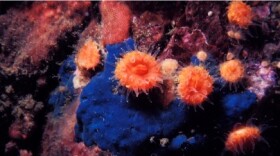If you trek to Mount Rainier National Park every summer to catch the spectacular display of wildflowers, take note: In the future, some flower species may bloom earlier while others could disappear altogether, according to a study from the University of Washington.
The study shows climate change could have a dramatic affect on wildflowers and wildlife in the park.
UW researchers report in a paper published online on Oct. 11 in the journal Ecology that they made their discovery because of the unusual weather in the Pacific Northwest in 2015.
Ecologist Elli Theobald says since 2010 they had been monitoring snow melt, temperature and wildflowers on Mount Rainier. Then, along came 2015, one of the warmest, driest years on record. She says it was a chance to see into the future.
"It turns out the conditions in 2015 were actually what we expect the conditions to be like in the 2080s if climate change continues on the trajectory that it's on," Theobald said.
Researchers found when snow melts earlier and temperatures are warmer, some wildflowers, like the avalanche lily, would bloom earlier. But that wasn't all. Things would be all jumbled up.
The perennials would flower more than once or not at all, and flower species that normally didn’t bloom at the same time would come up together. And because nectar varies by flower species, with some having a lot more protein, the shift would have a dramatic effect on bees and other pollinators.
“So it’s totally possible in the future that we'll have periods in the summer time when there is a kind of boom and bust period," Theobald said.
In other words, times when there will be a lot of nectar available for pollinators and times when there won’t. That could ultimately affect bears and other wildlife that feed on berries.







